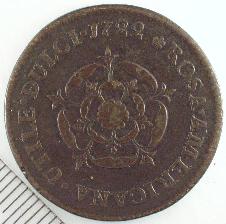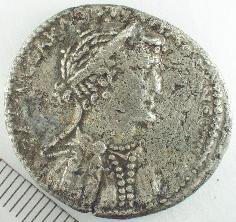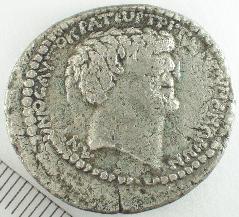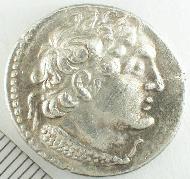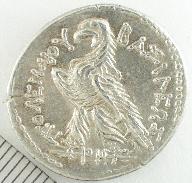Chatter
archive
also available
| Chicago Coin Club |
|---|
| Volume 51 No. 5 |
May 2005 |
|---|
Minutes of the 1036th Meeting
The 1036th meeting of the Chicago Coin Club was called to order
at 7:10 PM by President Robert Feiler with nineteen members and guests present.
Guests for the evening were Shari Zack and Joel Edler.
The March Minutes were approved as published in the Chatter.
Treasurer Steve Zitowsky reported March revenue of $384.00 and expenditures of $590.78.
The speaker for the evening was Alex Moulinas on the subject of Coin Grading Perspectives.
Professionally involved in numismatics since 1988, Moulinas also graded coins for the Numismatic Guaranty Corp.
In addition to sharing some of his experiences, Moulinas answered many questions from the members.
It was announced that the Central States Numismatic Society (CSNS)
will honor the Chicago Coin Club for 50-years of membership.
This will be done at the upcoming CSNS show in St. Louis, MO.
Cliff Mishler planned to attend the show, and he was asked to accept the award on behalf of the club.
Exhibitors for the evening were:
Dr. Saul B. Needleman: 17 euro coins in six denominations and from four countries;
Steve Huber: a 1901 Japanese yen and three Gedanken talers from 1914-15;
Robert D. Leonard: programs from 2005 ANA mid-year convention in Kansas City
and a gold tenth-ounce American eagle coin won as an
Early Bird prize in Bowers and Merena's numismatic survey;
Chuck Jacobs: five coins from Hong Kong and minted in England;
Mark Wieclaw: two ancient Roman coins, an ancient Greek coin and two American Colonial tokens;
John Connolly: U.S. proof sets showing doubling of letters;
Robert Feiler: www.wheresgeorge.com $1.00 federal reserve note, a token from Fargo, ND,
a $7.00 and an $8.00 colonial bill from Rhode Island dated July 2, 1780
and two restrikes from the French Mint of Castorland jetons;
Don Dool: five medals showing monuments outside Argentina dedicated to San Martin;
and Lyle Daly: a $2-1/2 U.S. gold piece with a die clash, two ancient numia pieces from Byzantium,
a falus dated 1865 from Morocco and 3 elongated cents from Chicago’s Century of Progress Exposition in 1933.
Prior to a break so members could view the exhibits, member Clifford Mishler, Iola, WI
announced that the Numismatists of Wisconsin plan to celebrate their 45th anniversary May 21, 2005 in Iola.
A flyer announcing all the activities was passed out and Club members were invited to attend.
Due to the commercial nature of the announcement, Cliff brought two apple pies from the Crystal Café in Iola.
The pies were a welcome refreshment during the exhibit viewing and a Cliff received a round of applause.
Under old business, Chuck Jacobs and Lyle Daly from BankOne reported
of a possible meeting room at no cost to the Club.
Members were advised to watch the next Chatter
and/or the Club’s web site for this possible change.
A moment of silence was held for Herb Schingoethe who passed away in March.
Herb and Martha Schingoethe were from Aurora, IL
and allowed images of their obsolete notes to be used for the Club’s souvenir currency project.
R.M. Smythe’s Auction Catalog II of their collection was made available to members at the meeting.
The Club’s souvenir sheet from the Chicago Paper Money Expo
was displayed and made available for $5.00 each.
Jeffrey Rosinia, the author, received a warm round of applause.
Robert Leonard reported on his project of writing the story of Togo Stone Money
that will become the souvenir of the Club’s meeting
at the Chicago International Coin Fair (CICF) on April 23rd.
The speaker for the CICF meeting will be Clyde Hubbard, Cuernavaca, Mexico on the subject
The First Coinage of the Americas, Mexico City 1536.
Members with unwanted auction catalogs were encouraged
to bring them to the Club’s table at the CICF where they will be sold.
Under new business, President Feiler announced that member Russ Wajda
suffered a heart attack, but was recuperating.
Feiler also announced an upcoming Board meeting to discuss survey results,
possible scholarship, publication of a book and video.
Don Dool commented on a recent trip to Argentina and his visits at several museums.
He announced that he had photographs of numismatic material on his laptop computer
and would be available after the meeting to share them with interested members.
The meeting was recessed at 9:11 PM and will be called to order again
at 1 PM on Saturday, April 23rd at the Chicago International Coin Fair,
Crown Plaza Chicago O’Hare, 5440 North River Road, Rosemont, IL.
Session II of the 1036th meeting was called to order
at 1 PM by President Robert Feiler with 31 members and 31 guests in attendance.
The meeting was held in conjunction with the
Chicago International Coin Fair, Crown Plaza Hotel, Rosemont.
President Feiler announced the new club meeting site
at Dearborn Center, 131 S. Dearborn, 6th Floor, Conference Room 6A, Downtown Chicago.
First V.P. Jeff Rosinia introduced featured speaker, Clyde Hubbard of Cuernavaca, Mexico.
Mr. Hubbard’s presentation “The First Coinage of America, Mexico City, 1536,”
used dual slide projectors to simultaneously show the obverse and reverse sides on 27 coins.
Hubbard has lived in Mexico for 60-years and shared his collecting experiences of this series.
Afterwards he made available a 14-page handout.
Rosinia presented him with an engraved Club medal
and an educational certificate from the American Numismatic Association.
Jerry Lebo, Secretary-Treasurer, Central States Numismatic Society (CSNS),
presented the Chicago Coin Club with a fifty-year membership medal.
President Feiler accepted the medal on behalf of the Club.
Robert Leonard was given a round of applause for his dedication
in authoring his 16th primitive money souvenir card for the Club
and presented with serial no. 3 of the Togo Stone Money card.
Speaker Hubbard was presented with no. 2 of the series.
The Club Archivist wasn’t present for presentation of serial no. 1.
Several members assisted in dispensing a souvenir card to everyone in attendance.
The meeting was adjourned at 2:05 PM.
Respectfully submitted, Carl Wolf
Secretary
Speaker's Wor[l]d
Coin Grading Perspectives
Presented by
Alex Moulinas
to our April 13, 2005 meeting.
Coin grading services and their slabs are a fixture
in contemporary US numismatics,
and they are expanding into world coins.
Alex Moulinas,
now with the international coin department at Harlen J. Berk Ltd.
but previously a grader with one of the grading services,
started the program by giving an overview of how the services grade;
then members asked questions of Alex,
sometimes with spirited followup discussions by the members.
A number of skills were discussed from how to look at a coin,
when to use magnification, and what magnification to use.
A wide range of topics also were discussed, including:
the grading practices of European dealers and such US specialty clubs
as the Early American Coppers (EAC),
attribution and other blunders on slabs,
net grading of coins with damage,
and even such recent coin-doctor tricks as laser-improved proof gold.
Had a few laughs and learned some new things;
you should have been there for this frank
presentation and discussion on grading.
Speaker's Wor[l]d
Coins of Charles and Johanna
Struck in the First Mint of the Americas
in Mexico City 1536-1572
Presented by
Clyde Hubbard
to our April 23, 2005 meeting.
The program started with a brief history lesson, covering
the Spanish conquest of Mexico (1519-1521),
the establishment of a city government in Mexico City in 1524,
and the arrival of the first Viceroy in 1535.
A mint was authorized in 1535,
and the mint produced its first coins in 1536.
Both a silver coinage and a copper coinage were authorized,
with the silver pieces denominated in reales and the copper in maravedis,
with 34 maravedis equal to one real.
During 37 years the Mexico City mint produced coinage in the name
of Charles and his mother Joan (the Mad).
Joan was the daughter of Ferdinand V and Isabel I
who had sponsored Columbus' voyages to the western hemisphere.
She had married Philip I, Archduke of Austria,
and their first son, Charles, born in 1500,
was King Charles I of Spain from 1516 to 1556.
(When he was Emperor of Germany from 1519 to 1556,
Charles was also known as Charles V.)
Because Charles spoke no Spanish when he arrived in Spain
with a large Flemish retinue,
Spaniards insisted that his mother,
although incompetent to rule, be joint ruler at least in name.
That is why the decree authorizing the mint in Mexico is signed
I THE QUEEN. By Order of His Majesty,
and that is why the coins include
Carolus et Iohana
as part of the legend.
Although both copper and silver coins were produced,
the copper pieces were not very popular then and are not readily available now.
Copper coins are known in the 2 and 4 maravedis denominations.
These silver coins are not cobs!
The cobs are a later coinage.
Although these coins are fairly consistent in thickness, shape, and fineness (93% silver),
the weight of an individual coin was not specified.
But 67 reales were to be made from one mark (230 grams) of silver.
The dies were made by punching elements of the design, not by engraving.
The first letter punches were of Gothic type,
and when broken were replaced by Latin type.
On the silver pieces, the obverse has a shield of Spain:
a castle in the top left and bottom right represent Castile,
and the lions in the top right and bottom left represent Leon.
The obverse has two crowned columns representing the Pillars of Hercules,
as the passage between the Atlantic and Mediteranean is known.
The 37 years of undated silver coinage in the name of Charles
and Joan is grouped into two series:
an early series (1536-1542) and a late series (1542-1572).
For the 1 real and larger pieces,
check the area below the columns on the reverse to distinguish
the early series from the late series
(the pillars do not appear on the fractional pieces).
Waves appear below the columns on the late series,
but no waves appear on the early series.
The assayer initials appearing on the early issues are
R, G, F, and P;
and silver coins were made in the denomiations of
¼, ½, 1, 2, 3, and 4 reales.
The assayer initials appearing on the late issues are
G, A, R, S, L, and O;
and silver coins were made in the denomiations of
½, 1, 2, and 4 reales.
The mintmark of either M or Mo indicates Mexico City.
Sometimes the positions (aside the pillars) for the mintmark
and assayer's initial were swapped,
and sometimes a letter would be punched in upside down.
Clyde's slides showed those errors as well as a wrong shield;
the two lions representing Leon were swapped with
the two castles representing Castile.
And there were many different attempts at spelling the same legend.
Clyde spent some time explaining why the copper coins were unpopular,
even though refusing to accept them in payment was punishable by 100 lashes.
Spaniards paid coppers to natives,
but the Spaniards would not accept the coppers when selling
beef to the natives, ignoring the law.
The natives threw the copper coins into the lake;
many were found 50 years ago during excavations for the new airport.
Nesmith's The Coinage of the First Mint of the Americas at Mexico City 1536-1572
published by the ANS in 1955 is a recommended work.
Although recent hoards have changed the rarity ratings,
the methodology is still used.
The obverse and reverse design determine the Nesmith number,
then look at the obverse and reverse legends.
Having been involved with coins for many years,
Clyde was around when some large hoards and accumulations came to the market;
he had some good stories about them.
When rebuilding a shrine in Mexico City in the 1950s,
a hoard of over 3,000 pieces was found;
2,000 were of Charles I.
Brief mention was made of a hoard recently discovered (in Cuba?),
but Clyde never did get around to finishing that story.
Or, maybe he told it to those who stayed after the meeting?
Those attending the meeting received a heavily illustrated 14-page handout prepared by Clyde.
Show and Tell
Presented at our April 13, 2005 meeting.
Each image has a scale in the lower-left corner,
with the tics spaced 1 mm apart.
Because the brightness and contrast were manipulated on a computer,
the coloring of a coin's image differs from the coin's actual coloring.
-
Saul Needleman
showed a number of euro coins,
and that lead to observations on the changing designs.
The coins ranged over many denominations,
from a one cent copper piece to a 2 euros bimetallic piece.
Saul pointed out that each denomination has a unique edge treatment:
there are grooves about ¼-inch apart on the 20 cent,
and large reeding is on the 50 cent.
For the euro's first years, each denomination's design was supposed to be
similar across all countries,
with the denomination very large on one side;
some recent pieces have more individualistic designs.
-
Steve Huber
showed two world silver coins and three gedanken talers:
-
A 1901 1 yen from Japan lists its silver weight and purity.
It was intended to be an international trade coin.
-
An 1874 5 franc from France's Third Republic period;
this coin is in a very nice condition,
and the slab's grade agrees.
-
A 1914 Hindenburg piece;
the reverse shows a warrior wrestling a giant.
-
A 1914 General v.Kluck piece;
on the reverse, a nude fiery rides a horse towards Paris.
-
A 1915 piece for General v.Mackensen, the eastern front commander.
-
Robert Leonard
attended the recent ANA convention in Kansas City,
and he showed us the program, exhibit guide,
and numismatic theater programs.
Those were much smaller than the ones for the typical summer convention,
and Bob estimated the bourse at about two thirds the size
of the summer bourse (Steve Huber placed it at about one third).
There might have been one international dealer,
unlike the summer when there is a good number.
Heritage conducts a collector survey each year,
and holds a prize drawing among the responders;
although responding every year, Bob never won.
This year Bowers & Merena had a survey with a drawing,
and Bob showed his tenth ounce (gold) eagle early bird prize.
-
Chuck Jacobs
showed some early early small-denomination pieces from Hong Kong,
which the British created in 1842 after winning the first opium war,
and expanded after succeeding wars.
-
An 1863 1 mil Pattern (small);
the denomination of one-thousandth of a dollar was known as one cash or wen.
-
An 1863 1 mil Pattern (large).
-
An issued 1863 1 mil piece.
-
An 1866 1 mil piece with the wrong Chinese character used:
it says "one thousand" instead of "one-thousandth."
-
An 1879 1 cent coin.
Chuck concluded with a recent stamp showing the first 1 mil coin.
-
Mark Wieclaw
showed two old coins designed by William Wood, then three ancient coins.
-
A 1723 half penny with George I on the obverse
and a woman holding a harp on the reverse.
Intended for Ireland but not accepted,
so they were sent to the American colonies.
-
A 1723 Rosa Americana penny intended for the American colonies.
-
An antoninianus of Claudius "Gothicus" II with his portrait to the the left;
rare for him.
-
A Syrian tetradrachm from 36BC with Cleopatra on the obverse
and Mark Anthony on the reverse.
At first glance, Mark Anthony's bust looks horrible,
as if the die engraver had started with the neck and worked upwards,
running out of room after the eyes.
But that is wrong; the coin is double struck.
Notice the two beaded borders at 8 o'clock,
and the faint outline of the back of the head located to the left of the neck.
-
A silver didrachm of Egypt's Ptolemy VI (180-145BC).
On the reverse, an eagle stands on thunderbolts
bearing the letters PH for year 108.
-
John Connolly
looks for varieties and production errors in both circulation and sets from the mint.
He showed some recently found examples of strike doubling in proof sets:
on an Oregon quarter in a 5-coin set,
and on a Kansas quarter in an 11-coin set.
-
Robert Feiler
brought exhibits covering a wide range:
-
A dollar bill with the Where's George web site's address,
http://www.wheresgeorge.com.
-
A semi-circular token from Fargo, ND;
the size of half of a half-dollar.
-
Two recent additions to his collection of odd denomination currency:
$7 and $8 from Rhode Island, with the date July 2, 1780.
-
Jetons in brass and silver from Castorland, in upstate New York;
these modern restrikes are available from the Paris Mint, France.
-
During his recent trip to Argentina,
Don Dool
acquired 66 medals,
with 50 for his San Martín collection.
Don showed five medals honoring monuments to San Martín located outside of Argentina.
Don told how one dealer bought a collection of 10,000 medals,
of which 1,000 were related to San Martín;
Don bought some of those.
-
Lyle Daly
is another collector with varied interests.
He showed:
-
A 1908 $2½ Indian bought as a type coin,
but high magnification showed a die clash.
-
Two Eastern Roman (Byzantine) items from a dealers junk box:
a uniface piece of Heraklius Constantine (610-640AD),
and a cast coin from a later era.
-
And four items from a flea market:
three elongated cents from the 1933 Chicago's World Fair,
and a possible rollout from a sportsman show
but no sign of the underlying cent is seen.
Our 1037th Meeting
| Date: | May 11, 2005 |
| Time: | 7:00 PM |
| Location: | Downtown Chicago
New Location!
At Dearborn Center, 131 S. Dearborn, 6th Floor, Conference Room 6A (right off the elevator lobby).
Please remember the security measures at our meeting building:
give a club officer the names of all your guests prior to the meeting day;
and everyone must show their photo-ID and register at the guard's desk. |
| Featured speaker: |
- to be announced |
|
|
Important Dates
| May |
11 |
CCC Meeting - Featured Speaker - to be announced |
| |
Our June meeting will consist of two sessions:
we will end the first session with a recess (instead of an adjournment),
and we will reconvene for the second session at the Chicago International Coin Fair. |
| June |
8 |
CCC Meeting - Featured Speaker - to be announced |
| June |
24-26 |
MidAmerica Coin Expo
at the Donald E. Stephens Convention Center, 5555 North River Road, Rosemont, IL.
Admission is $5. |
| June |
25 |
CCC Meeting - 1pm at the MidAmerica Coin Expo,
which is held at the Donald E. Stephens Convention Center, 5555 North River Road, Rosemont, IL.
No admission charge for our meeting.
Featured Speaker - David Sundman on 19th Century 3-D Slides of the U.S. Mint |
| |
| July |
13 |
CCC Meeting - Featured Speaker - to be announced |
Birthday and Year Joined
| June |
7 |
Harlan J. Berk |
1995 |
| June |
11 |
Joseph A. Piekarczyk |
1991 |
| June |
12 |
Rosalind Ryant |
1977 |
| June |
27 |
James Simek |
1973 |
Chatter Matter
All correspondence pertaining to Club matters
should be addressed to the Secretary and mailed to:
CHICAGO COIN CLUB
P.O. Box 2301
CHICAGO, IL 60690
Visit Our Web Site
http://www.ChicagoCoinClub.org/
Contacting Your Editor
prhybert@worldnet.att.net
Club Officers
| Robert Feiler | - President |
| Jeff Rosinia | - First Vice President |
| Lyle Daly | - Second Vice President |
| |
| Directors: | Phil Carrigan
Carl Wolf
Steve Zitowsky
Mark Wieclaw |
| |
| Other positions held are: |
| Bill Burd/Carl Wolf | - Secretary |
| Steve Zitowsky | - Treasurer |
| Paul Hybert | - Chatter Editor |
| William Burd | - Archivist |



